If you like the idea of taking a plane to a beautiful beach check out this list of Australian beachside Airports. There is something on the list for every type of pilot and plane. All the 22 airports on the list are within a short walk of the beach and are all unique in their own way.
This article is trying to pick the best Beach Airports from across Australia. I will also publish some other regional airport articles which feature some of the great airports that didn’t make it on the list.
The list is organized in some sort of rough geographical order. We will hit up the east coast of Australia first and then head around the south and west coast of Australia. Lastly, we quickly shoot across the top end and back to where we started.
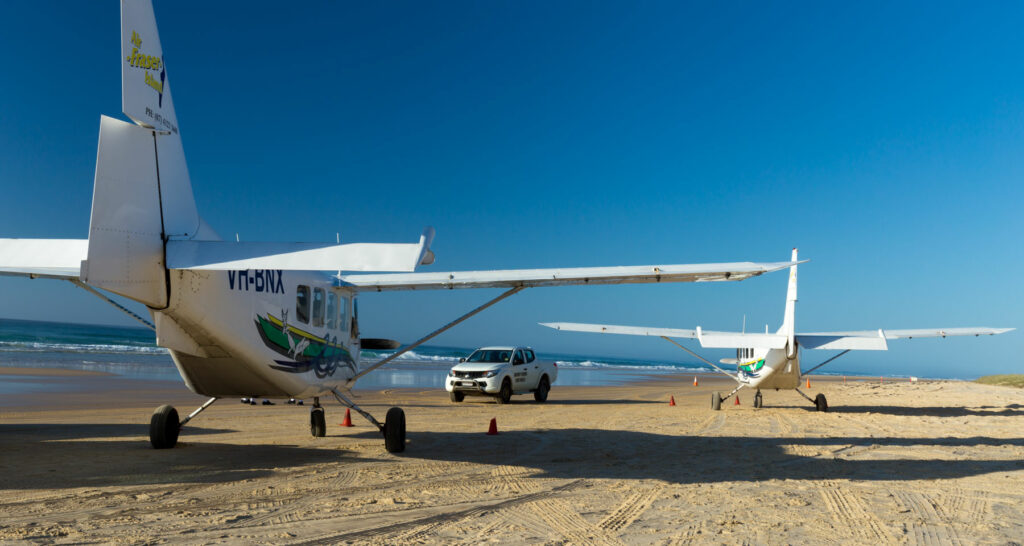
You don’t get more of a beach airport than when you actually land on the sand. Eurong beach is an official Airstrip.
A guy called Harry Geltch managed to convince Australian regulators that Commercially landing aircraft on the busiest sand highway in the world was a good idea. It seems to be too, his company Air Fraser Island has been successfully doing it since the 70s. These days the company operates Australian-made GippsAero GA8 Airvans pictured above.
Tourists wanting to visit the island can take a scheduled flight one way and a 4WD safari back or a flight both ways. Flights are surprisingly affordable starting at $99 per way.
Landing with your own plane requires special arrangements and probably a bit more skill and bravery than your average pavement landing. If you want to hang around for a while there is the lovely Eurong resort here with all the creature comforts.
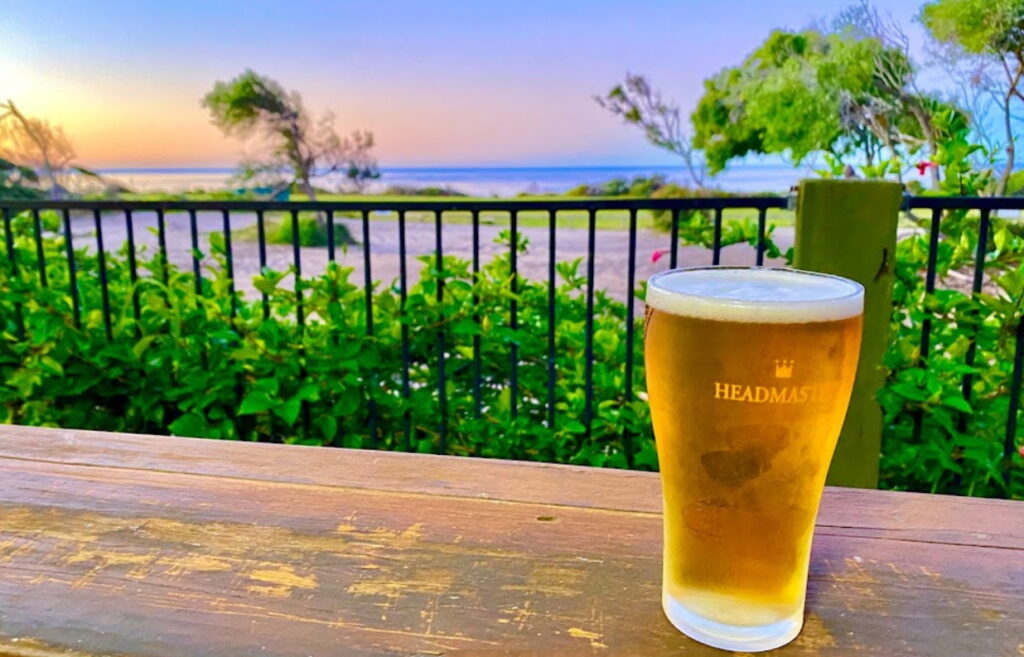
Just 70 km north of Eurong on Fraser Island is Orchard Beach Airstrip which is, without doubt, the perfect $100 dollar hamburger destination. Touch down on a 750 m grass strip smack bang in the middle of a UNESCO world heritage site. See wild dingoes, rare birds, and even the occasional giant sea turtle.
When you are ready, stroll over to the Driftwood Bar to enjoy refreshments and some pretty views out to the Coral Sea and Great Barrier Reef.
If you don’t fancy flying back straight away you can find nice accommodation at the Orchid Beach Resort.
Getting to this remote outpost by air is a short 20-minute flight from Harvey Bay or a fraction further from Rainbow Beach – that same drive would take between 6-10 hours depending on tides and barge crossings.
Be sure to calculate your Aircraft performance correctly as this site has seen a crash and few near misses over the years. More info on the airstrip including photos can be found here.
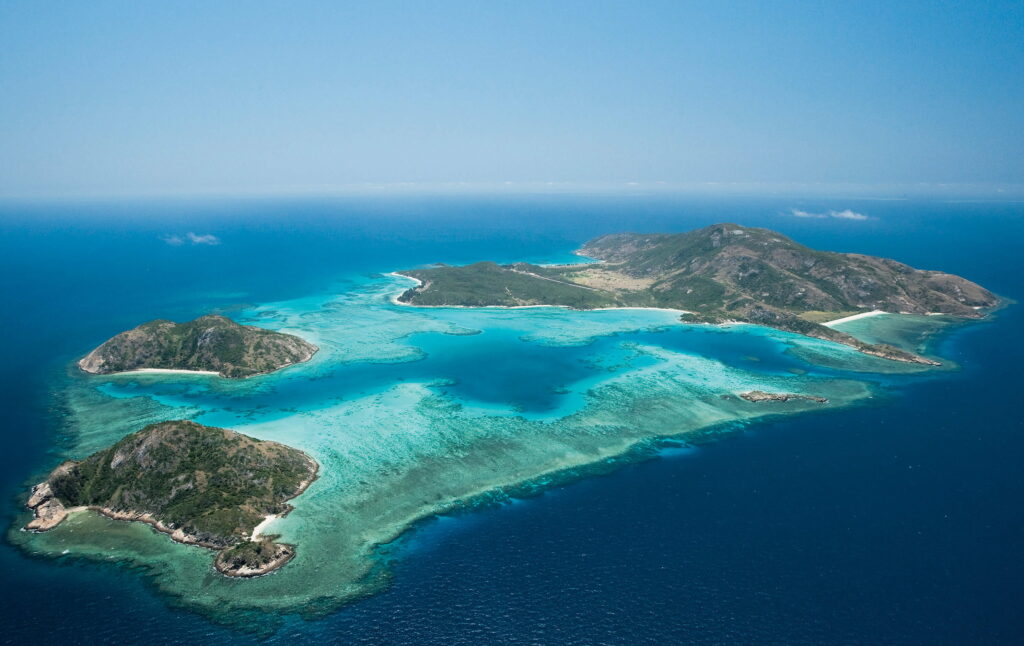
Featuring next on the list is Lizard Island Airport which is situated 250 km north of Cairns and 34 km off the coast. Here you will find a Tropical paradise and National park which is home to Queenland’s most exclusive and remote resort. You will find few places as untouched as this and it is right next to some of the best diving the Great Barrier Reef has to offer.
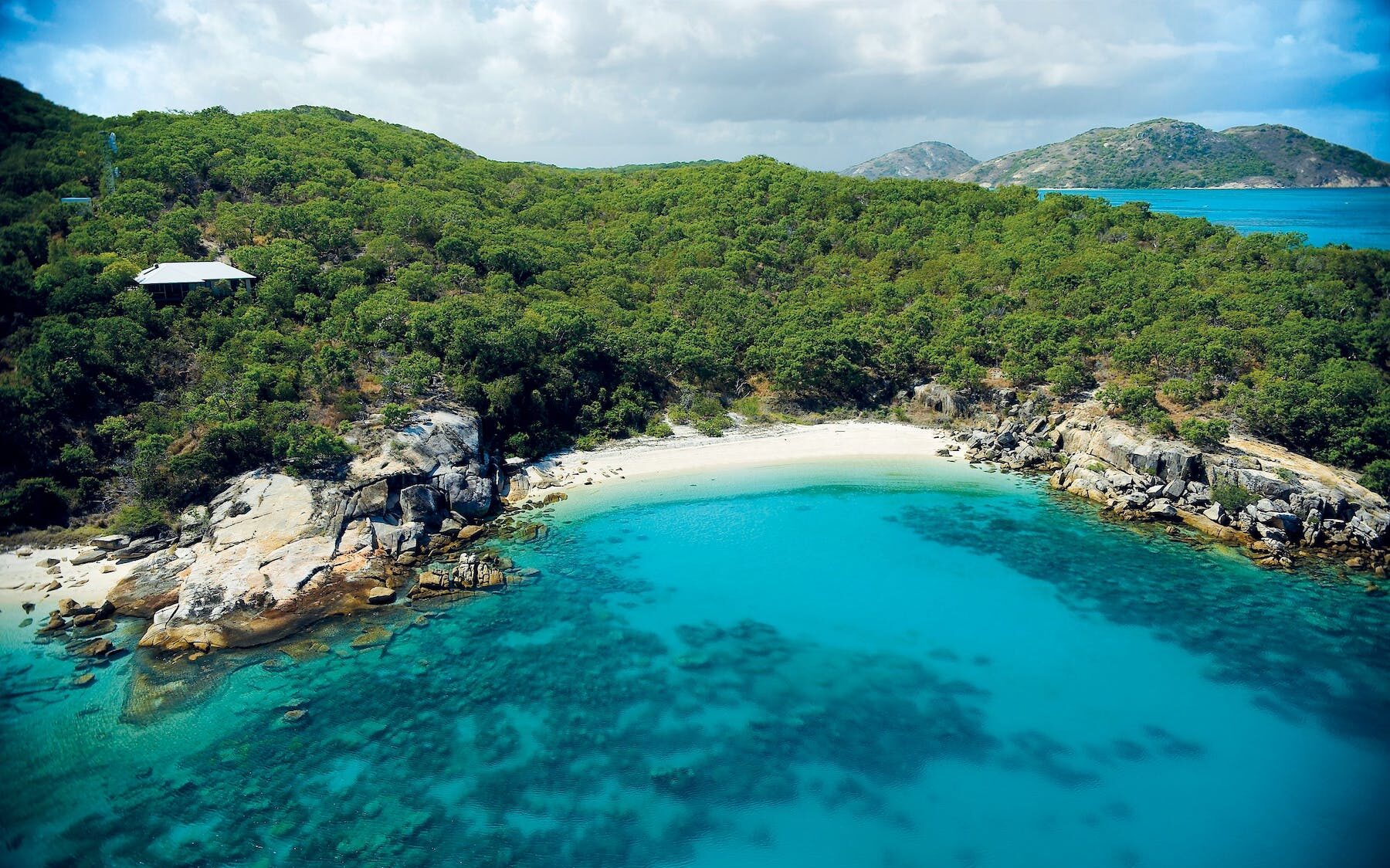 Blue Lagoon Beach at the south end of Runway
Blue Lagoon Beach at the south end of Runway
Lizard Island Luxury resort which operates the airport has only 40 rooms which go for between $2500 – $6500 a night.
The Airport on the island has a single 900 m paved runway which is long enough for most Piston and Turboprop Aircraft to operate from. Hinterland Aviation based out of Cairns operates a daily service for hotel guests.
Landing and parking fees for the airport are $300 a day but the good news is it is free if you stay at the resort.
The most beautiful beach on the island is Blue Lagoon Beach which is only a short 450 m from the airport. More information on the island can be found here.
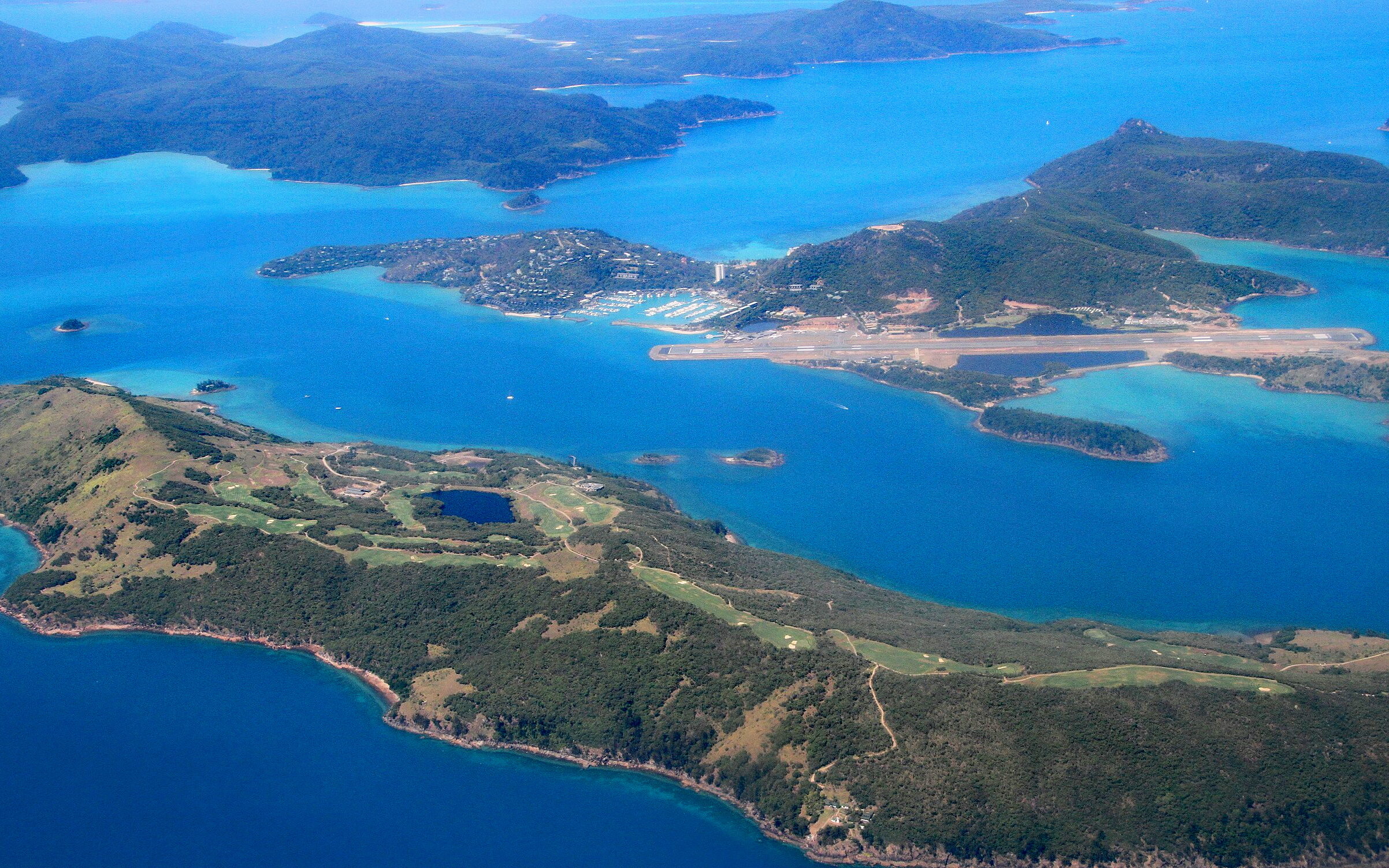
Situated 730 km south of Lizard Island and 890 km north of Brisbane is the now world famous Hamilton Island. It is the only island in the Great Barrier reef to have a full 1765 m long runway which is suitable for Commercial regional jets.
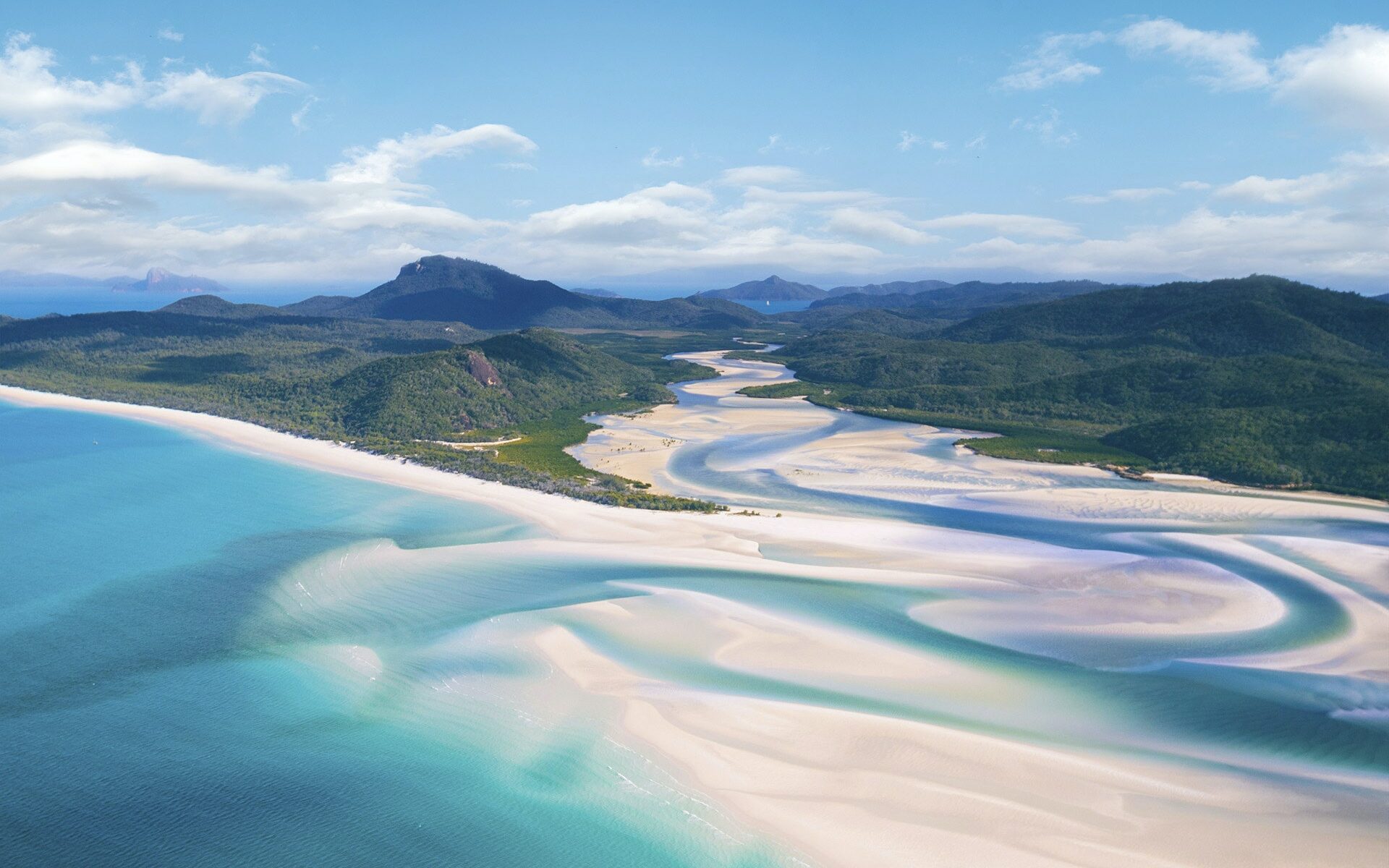 Whitehaven Beach and Inlet – Whitsunday Island
Whitehaven Beach and Inlet – Whitsunday Island
Hamilton Island itself is nice enough with beaches, bars and restaurants but the the real crown jewel is Whitsunday Island to the north. It has been designated a National park and thankfully development is forbidden.
It is possible for GA aircraft to book landing slots on Hamilton. Landing fees and parking are quite reasonable (under $100) given the nature of the airport.
On Hamilton Island you will find Catseye Beach on the far side of the island. It has all the resort facilites you could hope for. If you want to find something quieter the Coral Beach or Escape Beach might be better options. If golf is your thing you can also find an 18 hole golf course on neighbouring Dent Island.
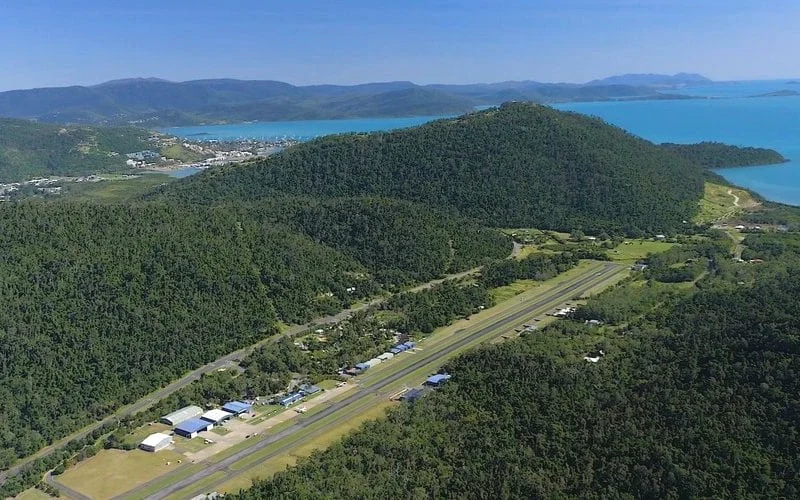
Whitsundays Airport is the perfect little Airpark just off the side of vibrant Airlie Beach. Enjoy the benefits of being on the mainland, while still being 10 minutes flight time from Hamilton Island and the other neighbouring airports.
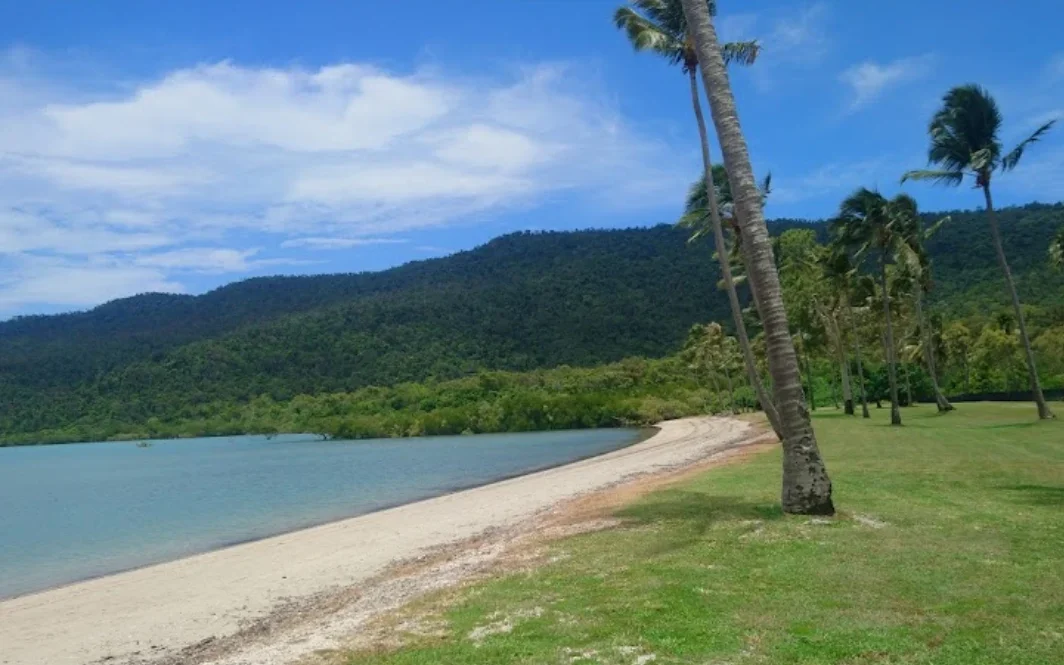 Funnel Bay Beach to the north of the airport
Funnel Bay Beach to the north of the airport
Whitsundays Airport is nestled in a gully between two mountain ridges, north of the Conway National Park. It is surrounded by lovely nature and beautiful hiking trails
At the airport you will find plenty of parking and everything you need from fueling to a cafe and shop. There is even a Family Eco Resort just meters from the runway.
Landing fees are only $22 and are waivered if you refuel. Parking fees are just $11 a night. As there are a lot of commercial operations, management ask you call ahead to book a slot.
The Runway itself is a sealed 1410 m by 15 m strip which should be enough for most GA aircraft.
At the north end of the runway is a nice little beach pictured above. Another option is to take a taxi into town and enjoy the free public Airlie Beach Lagoon.
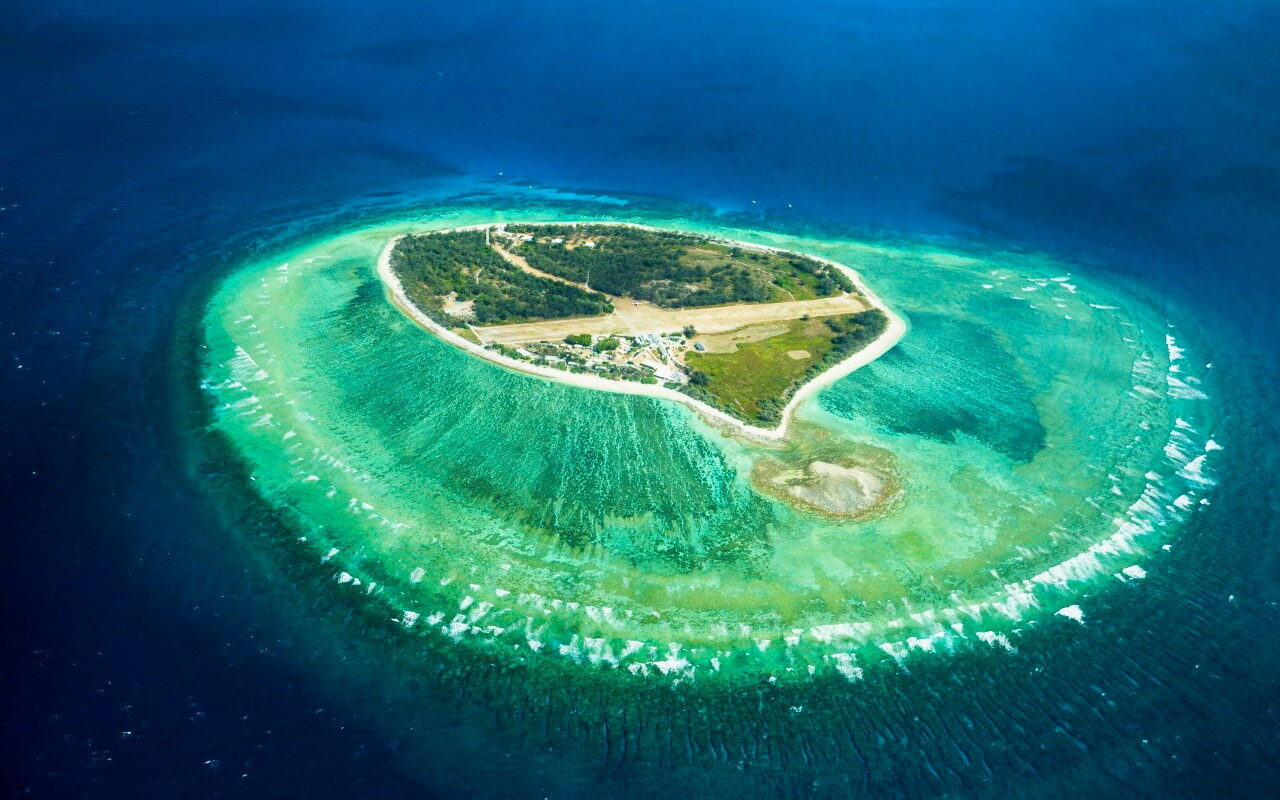
Only an aircraft owner would think to cut a lovely little island in half like that with a runway. This 600 m grass strip is located 81 km east of the town of Agnes Waters (the most northern surf beach in Australia) and 84 km northwest of Fraser Island.
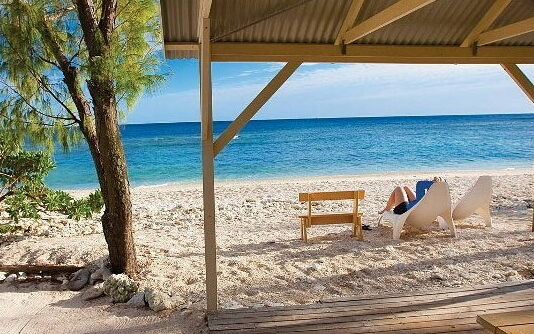 Coral Beach on Lady Elliot Island
Coral Beach on Lady Elliot Island
The island is formed on top of a corral reef and the beach is made up of broken coral rather than sand. You will find spectacular diving around the area.
The island has a history of exploitation when it was mined for Guano (petrified bird poop) which destroyed the vegetation on the island.
Things have improved for the better now thanks to a comprehensive conservation effort. An Eco Resort now operates from the island. There is no natural drinking water so the resort desalinates seawater.
Annoyingly now due to the conservation plan, private planes cannot land on the island. The only approved operator is Sea Air Pacific who operate daily flights from Bundaberg and Harvey Bay with their Cessna 208 Caravans.
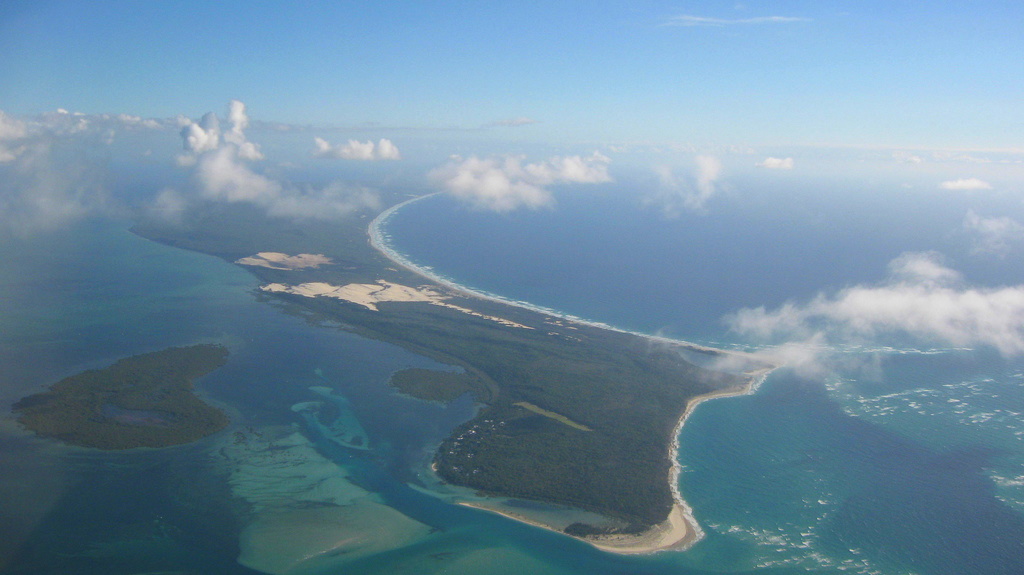
Fancy finishing work in Brisbane and taking a short 15 min flight to Moreton Island for a dip at a proper ocean beach? It would be much nicer than anyting on the Brisbane coastline which is mostly a muddy and smelly bay.
Baroco Airstrip is located 25 km off the coast of north Brisbane on the southern tip near the small settlement of Kooringal. The grass and sand strip is 650 m long and 30 m wide. Due to its soft sandy nature of the runway, there was an accident in 1986 with a Tomahawk that failed to get adequate airspeed to take off.
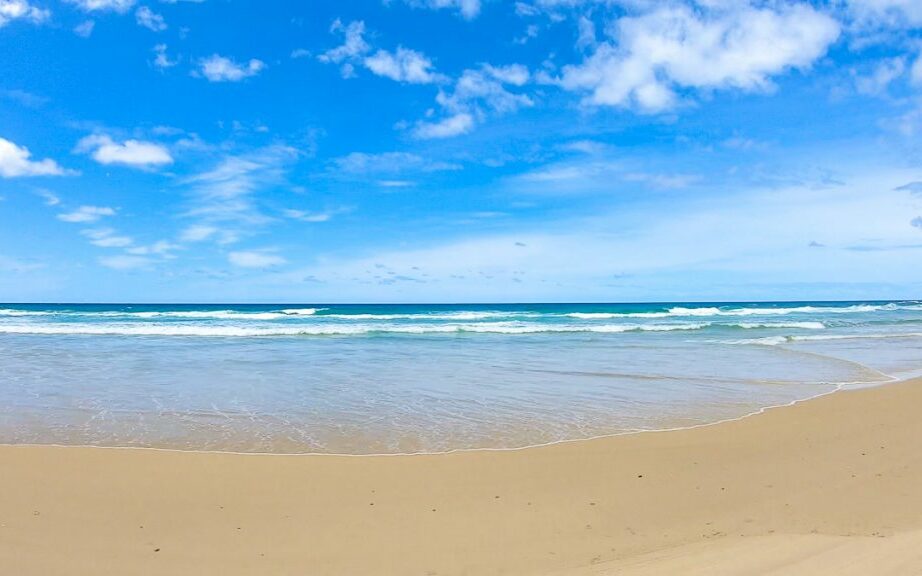 East side of Moreton Island
East side of Moreton Island
Moreton Island itself is 37 km long and 10 km at its widest point. Most of the island is a National park, but just like Fraser Island, 4WD vehicles are allowed to drive on the beach with a permit.
Apart from the lovely beaches, there is a nice bar and cafe in the Kooringal settlement called The Gutter Bar.
Moreton Island has a second runway called Tangalooma Airstrip on the mid western side of the island. It is around 1000 m long and is privately owned by the Tangalooma resort.
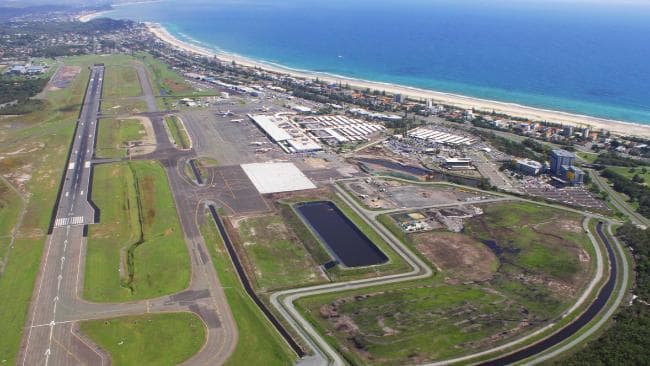
If you can’t get your aircraft stopped on a short grass strip then the Gold Coast Airport might be a better alternative. Its 2.5 km paved beachside runway should be sufficient for even the worst pilots among us. If you don’t have a plane don’t worry as this destination is also frequented by many convenient scheduled flights from Sydney, Melbourne, and Canberra.
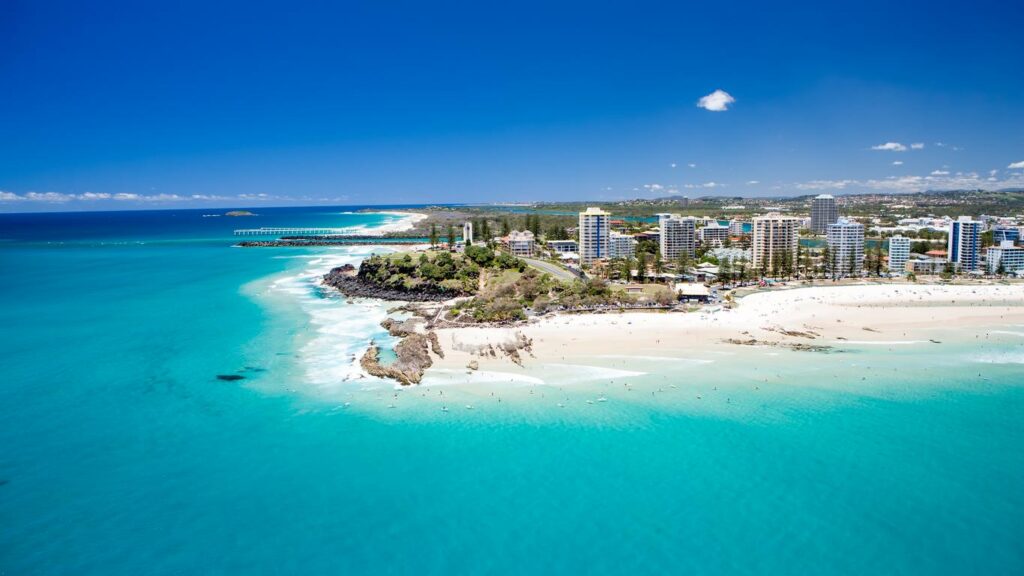 Rainbow Bay beach and Coolangatta Beach
Rainbow Bay beach and Coolangatta Beach
Gold Coast Airport makes on the list due to its accessibility and lovely beaches. Just a short walk through the airport car park and you can be walking on white sand and be enjoying the warm turquoise water.
Gold Coast airport is located at the quiet end of the Gold Coast. To the south is the Tweed river outlet and to the north is the Currumbin creek and Currumbin Wildlife Sanctuary. Interestingly the runway actually crosses state borders with the southern end being in New South Wales and the northern end in Queensland.
Landing and parking fees at the Gold Coast airport are surprisingly modest given that it is an International Airport. The fees listed on the website are around $20 per 1000 kg.
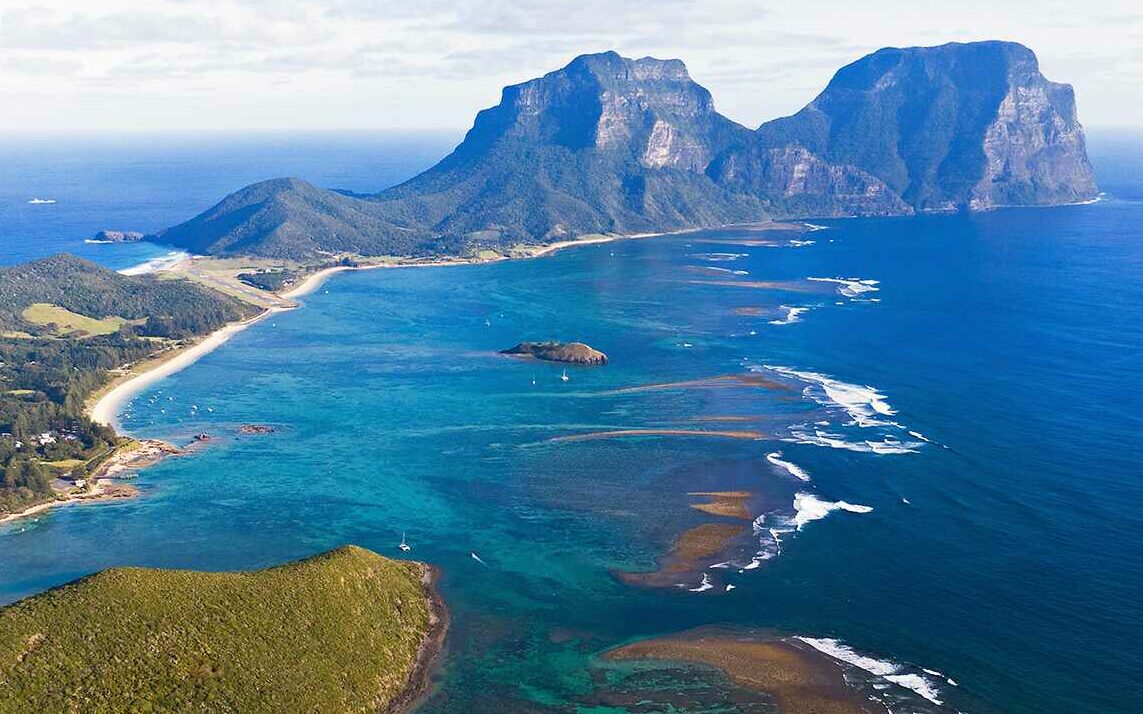
You need decent sized fuel tanks and plenty of courage to visit Lord Howe Island in a single engine aircraft. The cross from mainland Australia is known to be hairy at times with high wind and low visibility. If you make it you will be rewared with a marvel of nature.
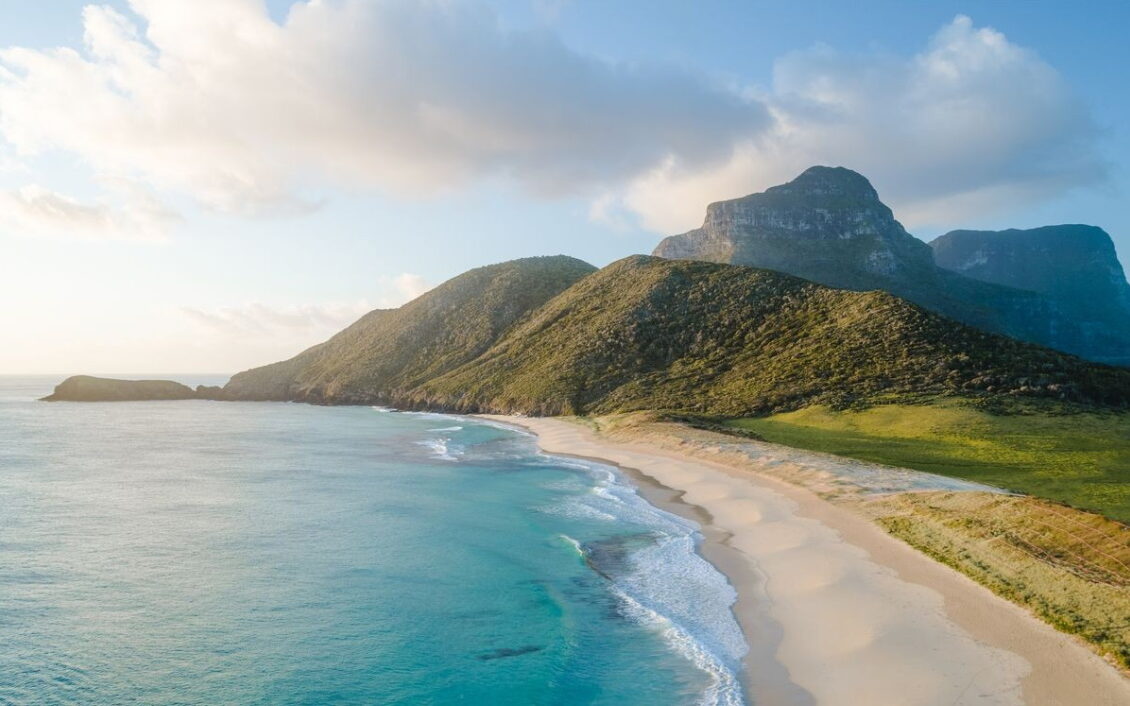 Blinky Beach at the end of Runway 10
Blinky Beach at the end of Runway 10
Situated 600 km east of Port Macquarie in the Tasman Sea is Australia’s most southern coral reef. Warm and cold currents converge here giving rise to spectacular biodiversity found nowhere else on earth. Here is a video about its unique nature.
Lord Howe Island runway is asphalt and just under 900 m in length which is should be adequate most non jet aircraft.
There is a process for getting prior approval to fly your aircraft to Lord Howe Island and a mandatory Biosecurity inspection on arrival. With all the fees and charges you won’t get much change of $300. There are also a few restaurants and guest houses to cater to the tourist market.
If you still have some courage left, consider flying another 900 km northeast to Norfolk Island. It is also spectacular and geographically much closer to New Zealand than Australia.
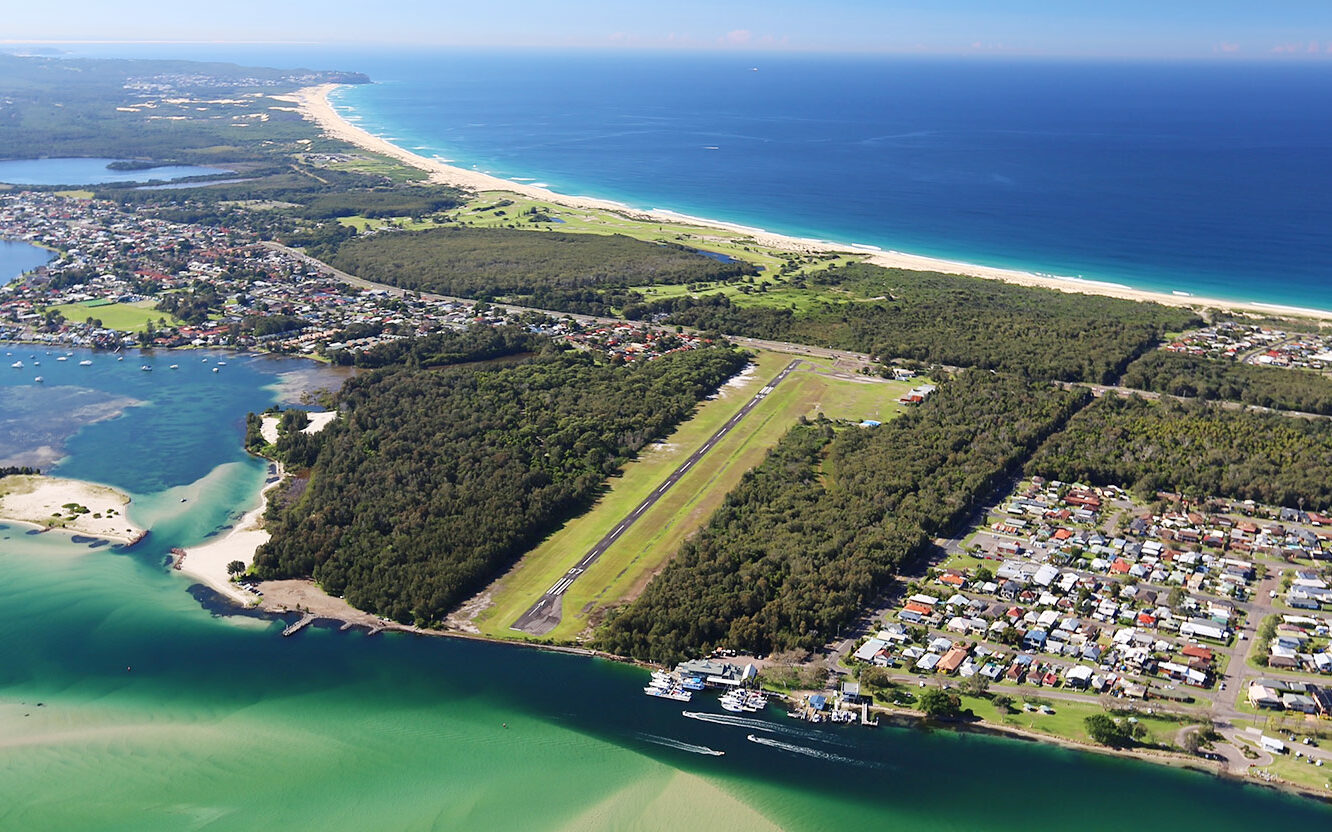
Lake Macquarie is a gorgeous airport sandwitched between a picturesque lake and the ocean. Located just 100 km north of Sydney and only 20 km south of Newcastle, this airstrip would be incredibly popular if it weren’t for rediculously expensive landing fees to keep everyone away.
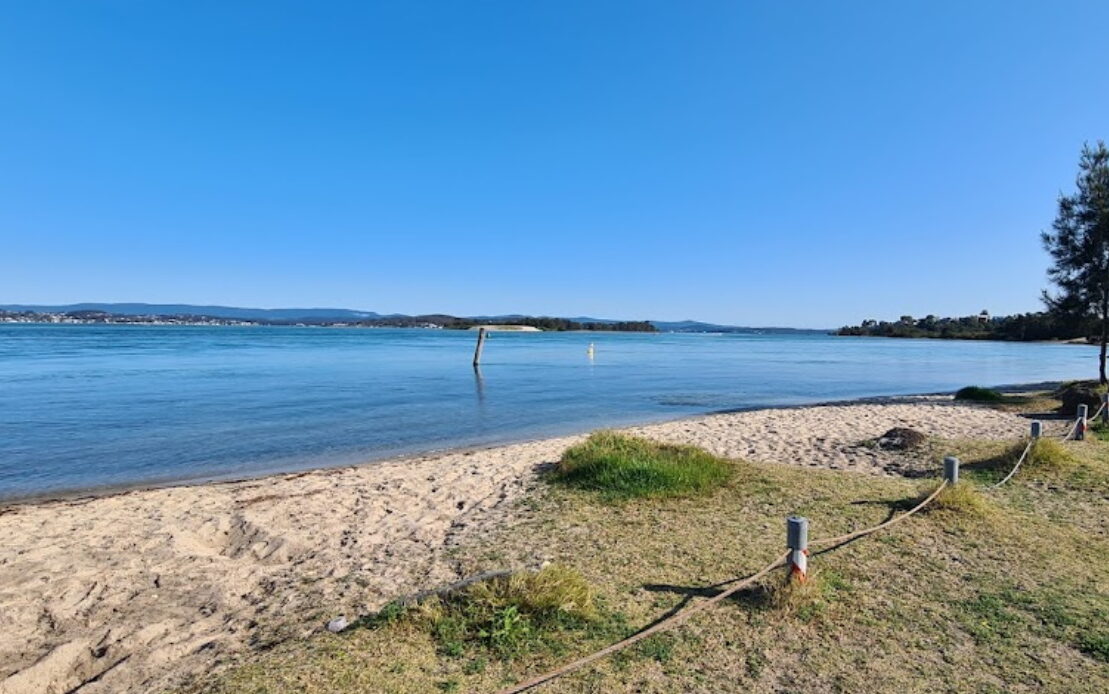 Naru Beach on the northwest side of the airport
Naru Beach on the northwest side of the airport
The sealed runway has a threshold of 650 m with an extended threshold 66 m on the west side and 155 m on the east side. If you manage to clear the highway and the trees it will be smooth sailing from there.
Getting to the ocean beach requires crossing a highway and walking on a path beside the golf course. The other option is to swim at the nearby lake beach just to the north of the field.
As mentioned, the landing fees are steep here, $275 plus a bureaucratic process for getting permission to land. Still, if you like nice swims and a bit of golf, it could be worth your while.
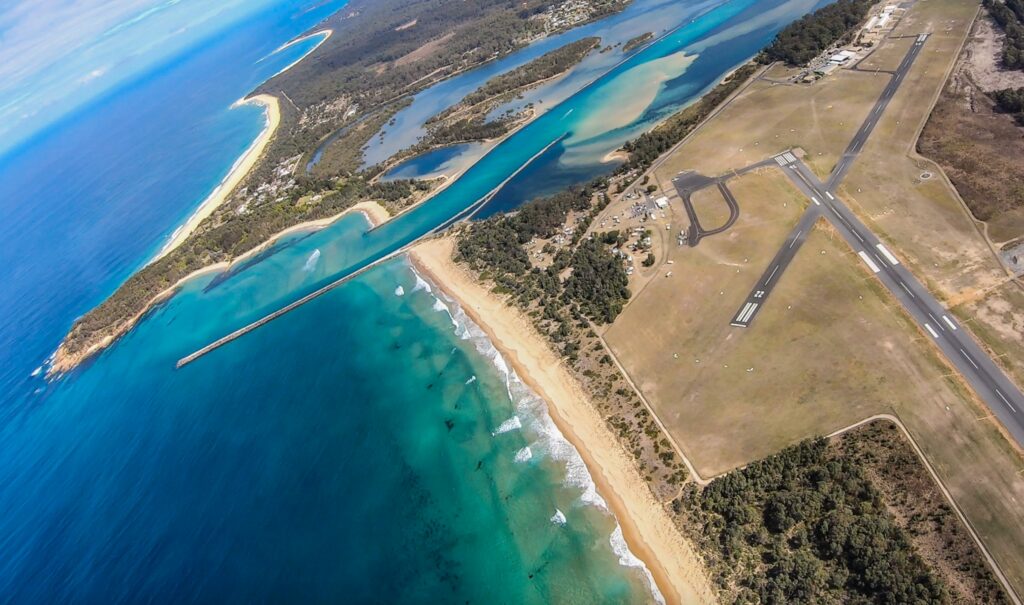
We skipped over Sydney and are now on the south coast of New South Wales, 230 km south of Sydney and 105 km from Canberra. This area of Australia is quiet and full of retirees from Canberra who managed to escape.
Moruya Airport was first licensed as an aerodrome in 1939 and was used by the Australian Air force. Nowadays there is a Skydiving school, Flight School, and Westpack Rescue Helicopter base here. Qantas offers scheduled flights to and from Sydney so the area is still well connected.
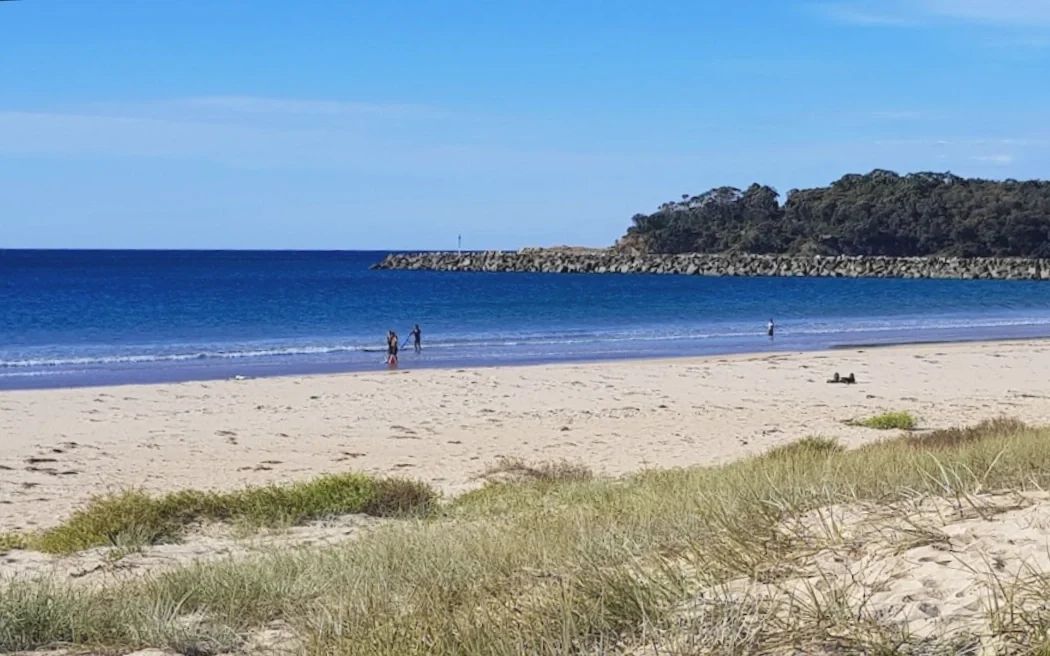 Moruya North Head end of Bengello Beach
Moruya North Head end of Bengello Beach
Moruya Airport’s longest runway is 1500 m with the other shorter runway measuring 800 m. There was a proposal to extend the longer runway further to allow regional jets but it did not get approved.
Landing fees at the airport are reasonable at $13 per ton with a minimum fee of $8.30.
Just outside the entrance to the airport is a beachfront campsite. The facilities here are basic but it’s beachfrot and only 50 m to the beach. The water here is usually calm and there is a nice walk along the river inlet.
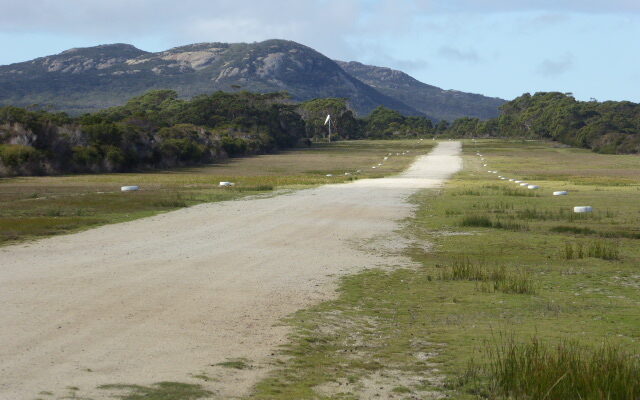
Killiecrankie Airport is a little known private airfield on the north end of Flinders Island, 337 km southeast of Melbourne. It can get cold her but you can’t argue with how lovely it is.
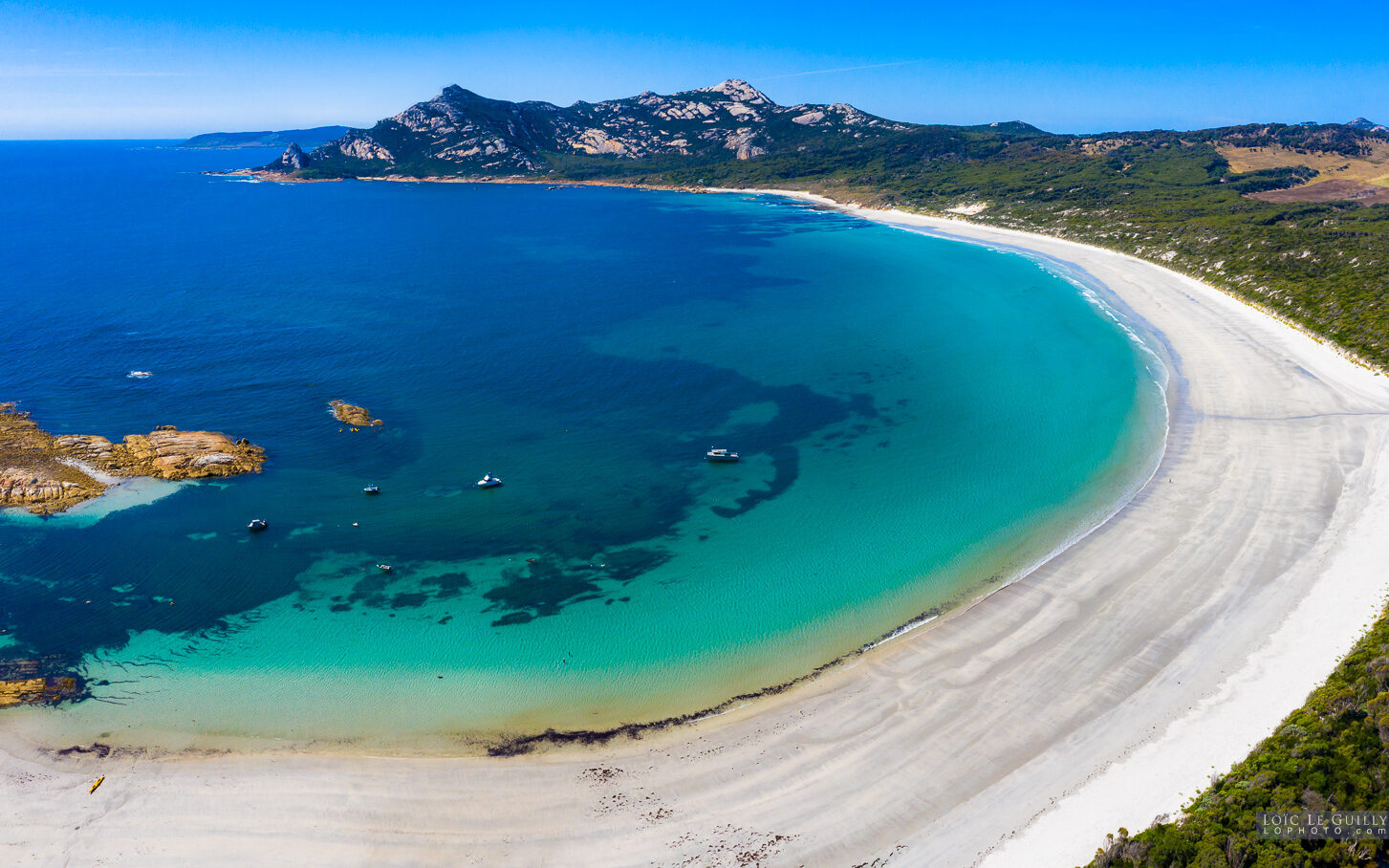 View over Killiecrankie Bay
View over Killiecrankie Bay
Killiecrankie Airport has a generous 1600 m gravel runway making it suitable for just about anything but a regional jet.
The airstrip is operated by Palana Beach House which is 10 km to the north. They ask that you contact them for permission to land.
Oddly the Palana Beach House is next to another airstrip called Sheiling Airstrip that is currently off the registrar but still visible on google maps. Maybe it was economical to just run one airport and this was the better of the two.
From Killiecrankie Airport it is a short 2.2 km walk to Killiecrankie Bay which is a Nature Recreation Area. There are a bunch of lovely Bed and Breakfasts for rent in the area.
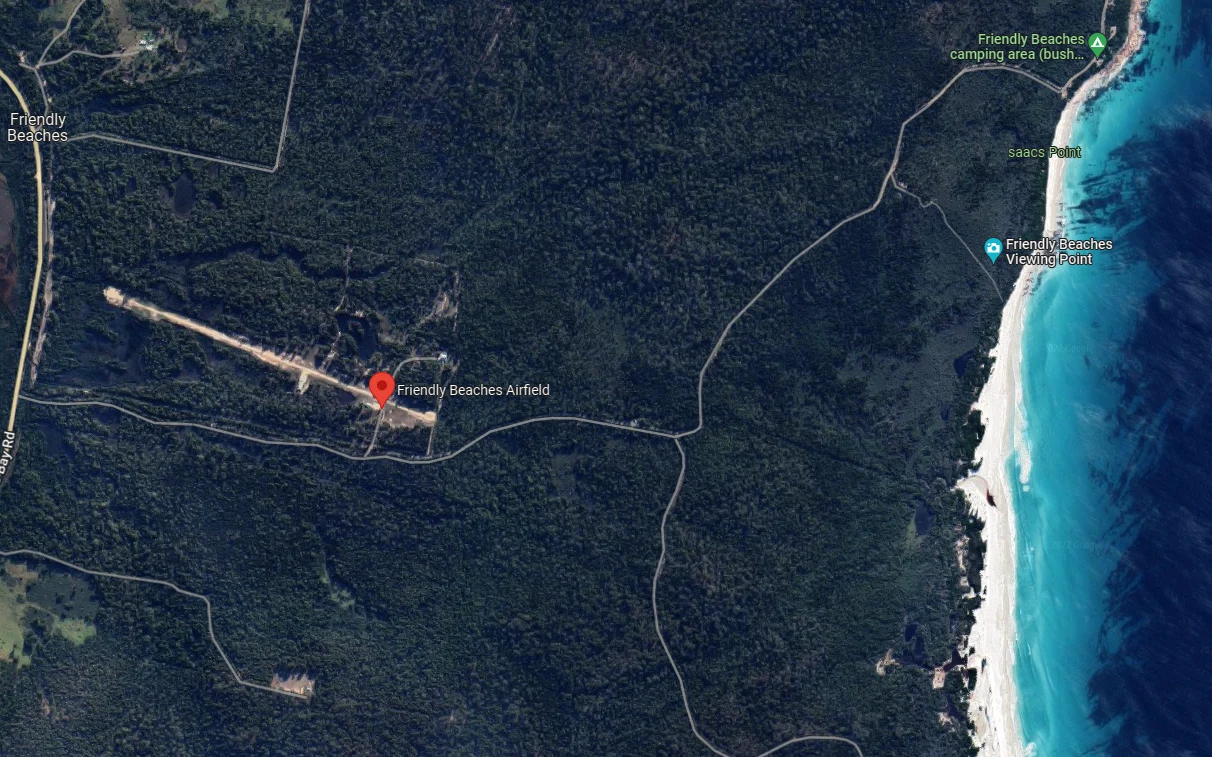
Tasmania’s nicest beaches are on the east coast of the island and Friendly Beaches is quite high on the Leader Board. It is only 12 km north of iconic Wineglass Bay.
Friendly Beaches Airfield 122 km northeast of Hobart. The runway is 1000 m long and 6 m wide with the surrounding trees being cleared to 26 meters.
Here is a video of an aircraft coming in for a landing on the strip.
The airfield is privately operated by Freycinet Air who do scenic flights along the coast. They do not charge landing fees for private aircraft.
It is a 1.5 km walk to Friendly Beach but it will be worth every step.
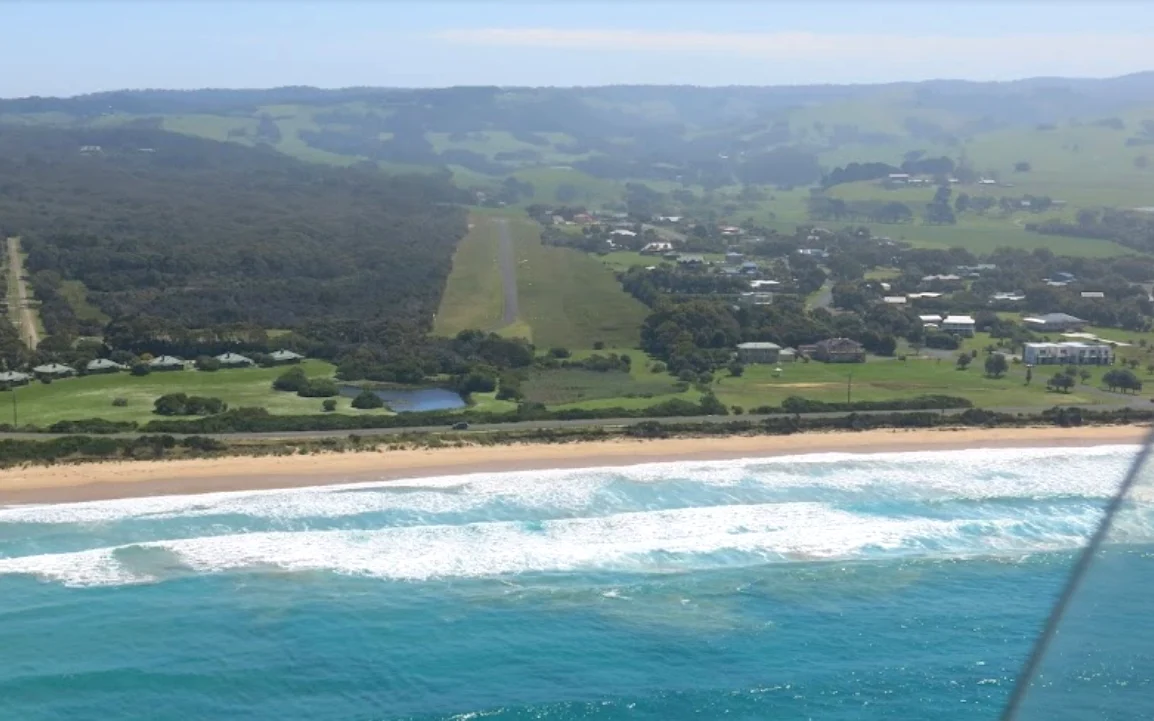
Apollo Bay just looks like the perfect place to go for a summer vacation. The airfield is located only 156 km southwest of Melbourne, making it easily accessable in under an hour flight for most aircraft.
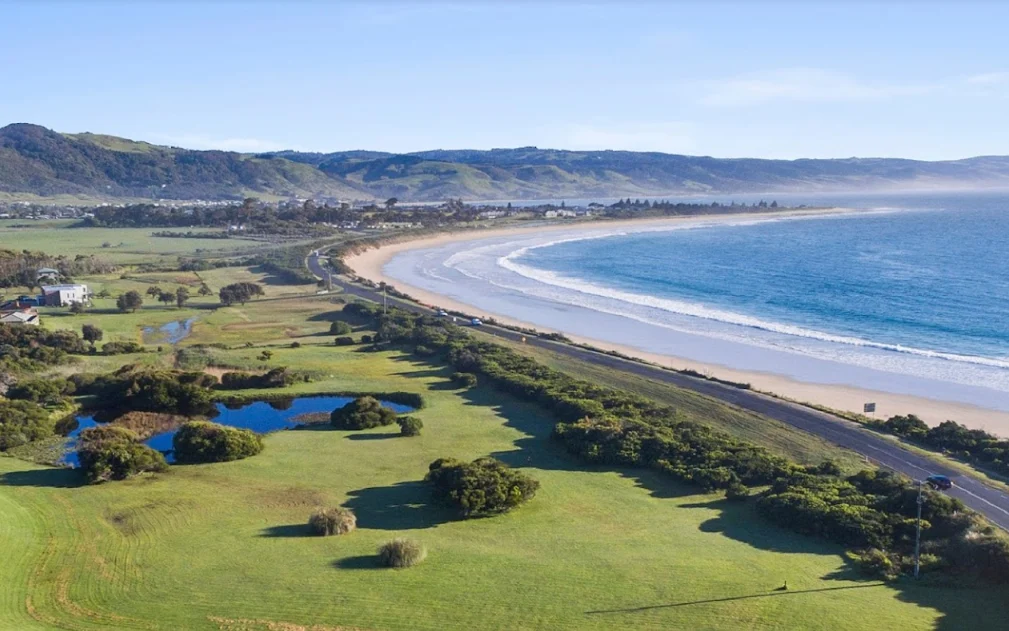 Beach on Mounts Bay just opposite the airfield
Beach on Mounts Bay just opposite the airfield
This part of Australia is lush green from the rain that comes off the Bass Strait. Tucked away to the west is the Great Otway National Park which contains beautiful rainforests similar to what you can find on the west coast of Tasmania.
Apollo Bay Airfield has a 740 m long and 6 m wide sealed runway that is operated by the local Colac Otway Shire Council. There are currently no set landing fees but there is a donation box if you want to contribute towards maintenance and repairs.
Just across the road from the airport is Mounts Bay which has a lovely beach and coastal walk. There are a bunch of cottages for rent in the neighbourhood. Apollo Bay town centre is a 2.5 km walk to the north.
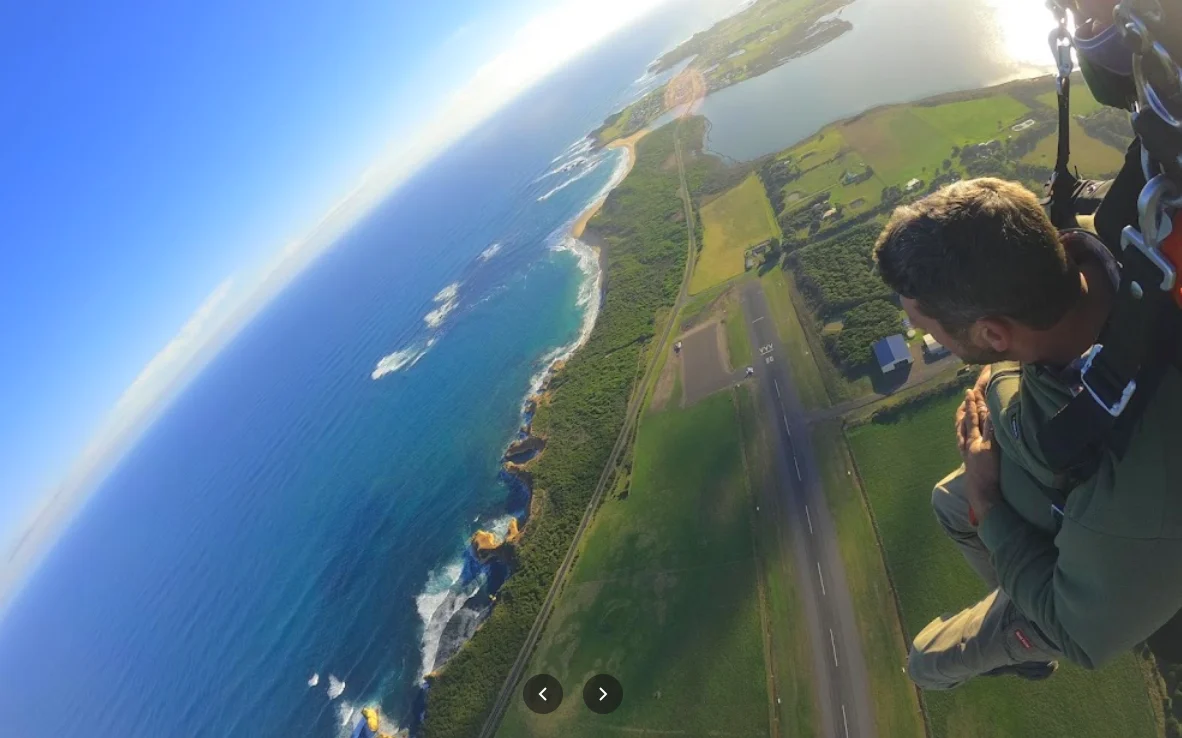
For those who want to visit the Great Ocean road but don’t fancy the 5 hour coastal drive this one might be for you. Peterborough / Great Ocean Road Airport is located 212 km southwest of Melbourne, right in the middle of Australia’s famous sandstone rock formations.
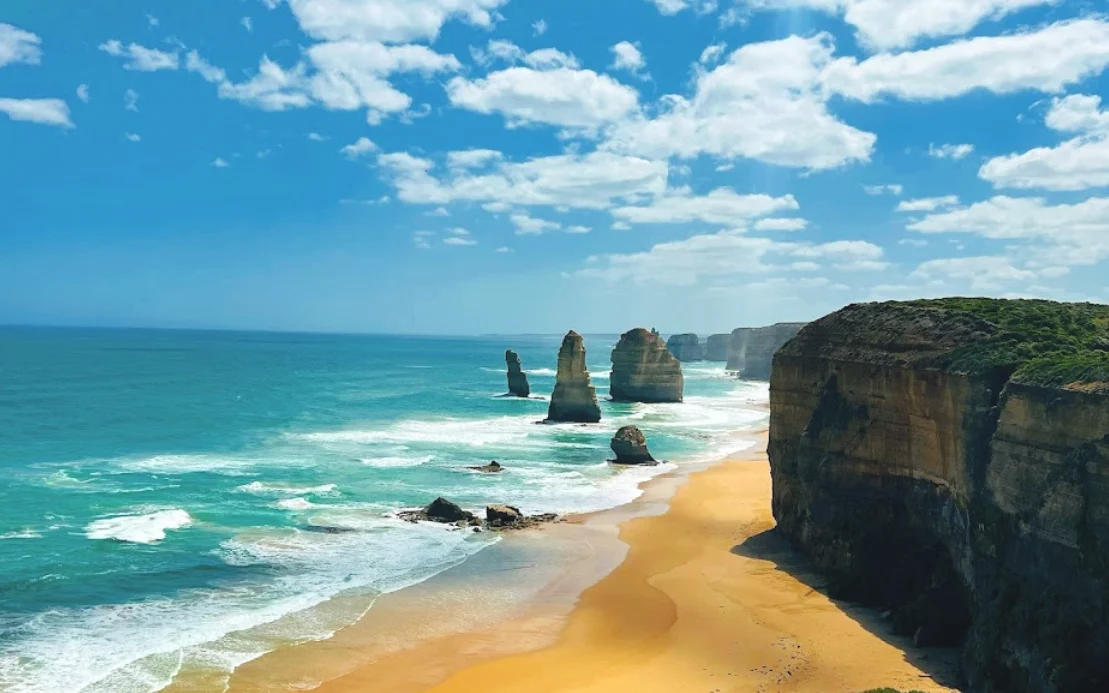 12 Apostles, 18 km east of the airport
12 Apostles, 18 km east of the airport
The Airport runway is a 1200 m by 30 m asphalt strip which is privately owned and operated by Glenample Air Pty Ltd.
The airport is mostly used for commercial activities including Helicopter tours, Sky Diving, and Charter but General Aviation aircraft are welcome. Contact details for the operator can be found in the Australian ERSA.
There is a lovely beach called Peterborough Beach just across from the airport. The town is also a short 1.5 km walk west of the airport.
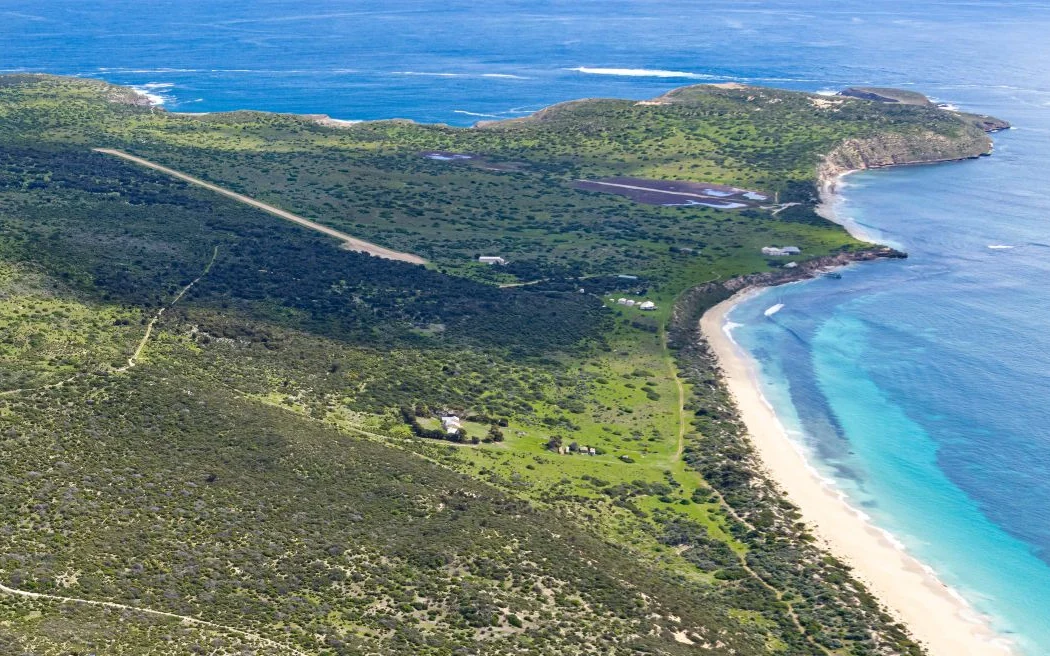
Wedge Island Airstrip is located in Spencer Gulf, South Australia, 189 km west of Adelaide. The island got its name because it looks like a giant door wedge from a distance. The nature here is gorgeous and the island has a rich history.
Wedge Island was settled during the 1850’s and used for farming but today there are a few holiday homes but it is not permanently settled. During World War 2 the Australian Airforce set up a radar on the island and had troops stationed there.
The island today is partly privately owned with the remainder being crown land.
The dirt airstrip on the island is 850 m long and registered as an Aircraft landing area in the Australian ERSA. For more information on the airstrip you can contact Wedge Island Holiday Accomodation. There is some parking space on the east end of the runway.
Just a short walk from the airstrip is a lovely 2 km long beach pictured above. The fishing is said to be really good on the island and there is a lot of bird life.
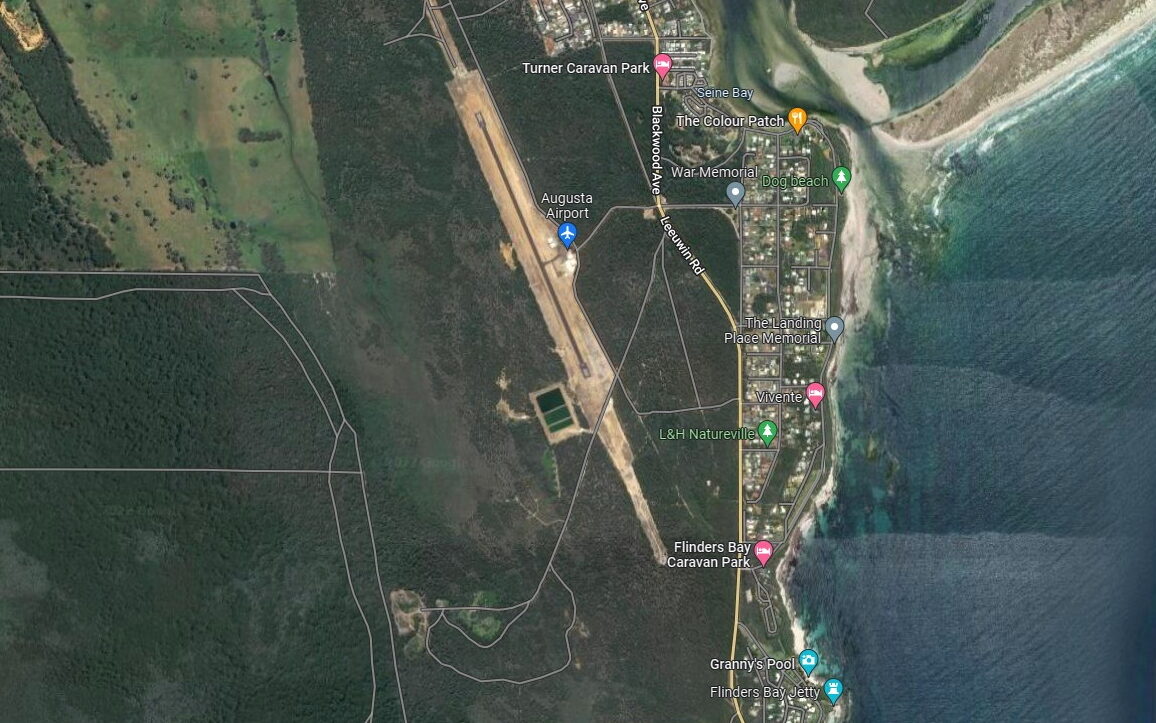
We are now in Western Australia and you are about to see why this state is famous for its beached. Augusta Airport is located on the southwestern tip of Australia, 270 km south of Perth. It is just around the corner from Historic Cape Leeuwin which is a popular tourist destination.
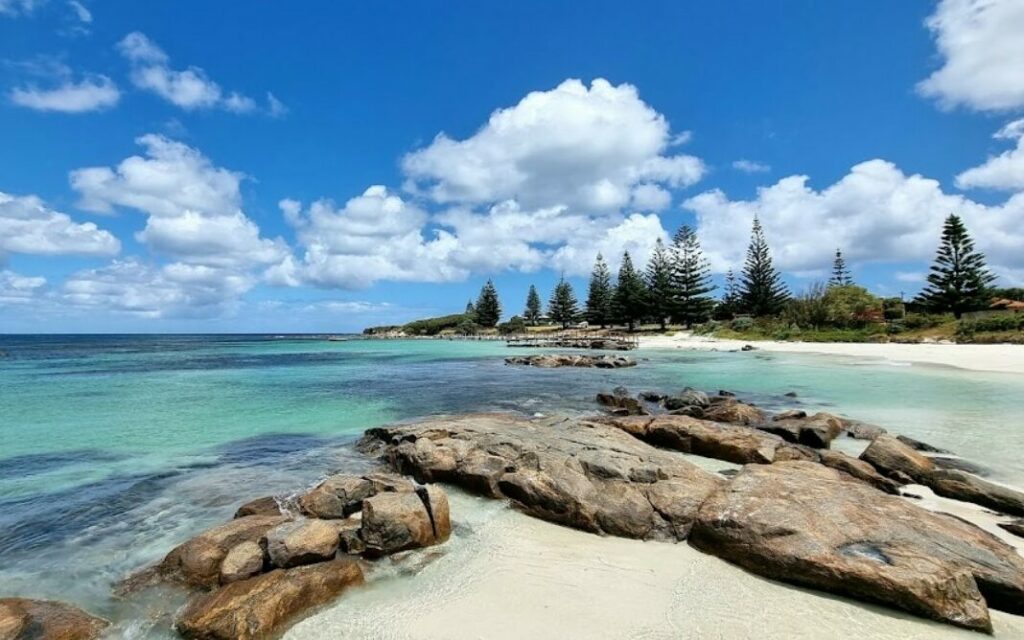 Granny’s Pool, opposite the airport
Granny’s Pool, opposite the airport
The Airport has a sealed 1100 m runway that is operated by the local council. They currently do not charge landing fees but all visits need to be reported and recorded.
The town of Augusta is a short 500 m walk from the airport. It has a population of around 1000 people with many of those moving there to retire and enjoy the mild dry climate.
As you can see from the picture, the beaches around the area are spectacular. It is quiet and only a short flight from a major Australian city.
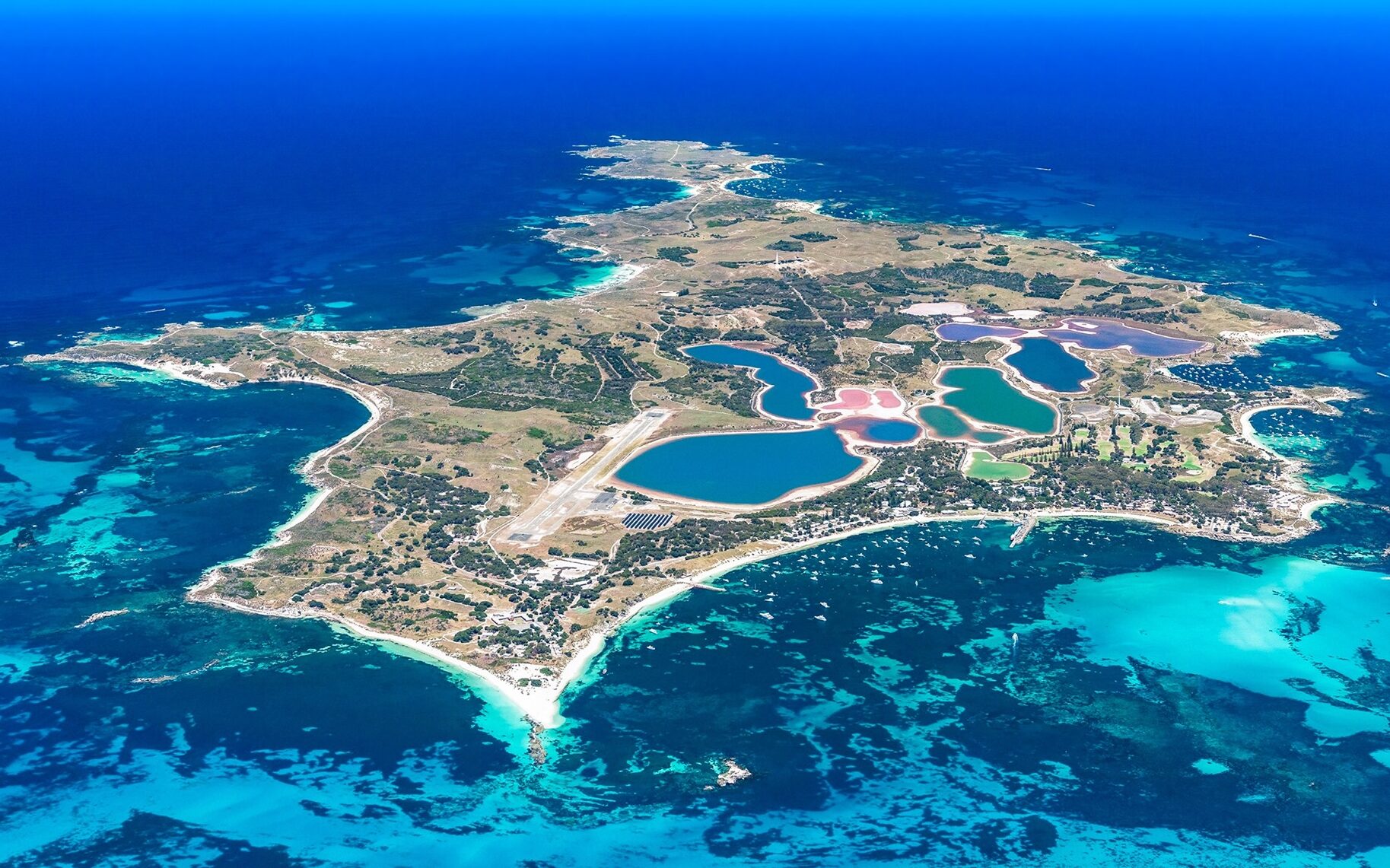
Rottnest Island (or Rotto to the locals) is located 18 km off the coast of Perth. The island is mostly made up of limestone with some futile soil. There is fresh water on the island in underground aquifers but for environmental reasons the 300 inhabitants today get their water from a desalination plant.
One of the first things to notice is the gorgeous white beaches and pretty salt lakes. There is even now a golf course on the north side of the island. Rottnest Island was farmed as early as 1831. After that, it became a prisoner camp for Aboriginals and then an internment camp during WW1 and WW2.
The airport on the island was first constructed in 1948 and has been improved a fair bit since. It is currently 1290 m by 18 m . There is a landing fee of $58 which includes the entrance fee to the island for 2 adults. More info can be found on the Airport website.
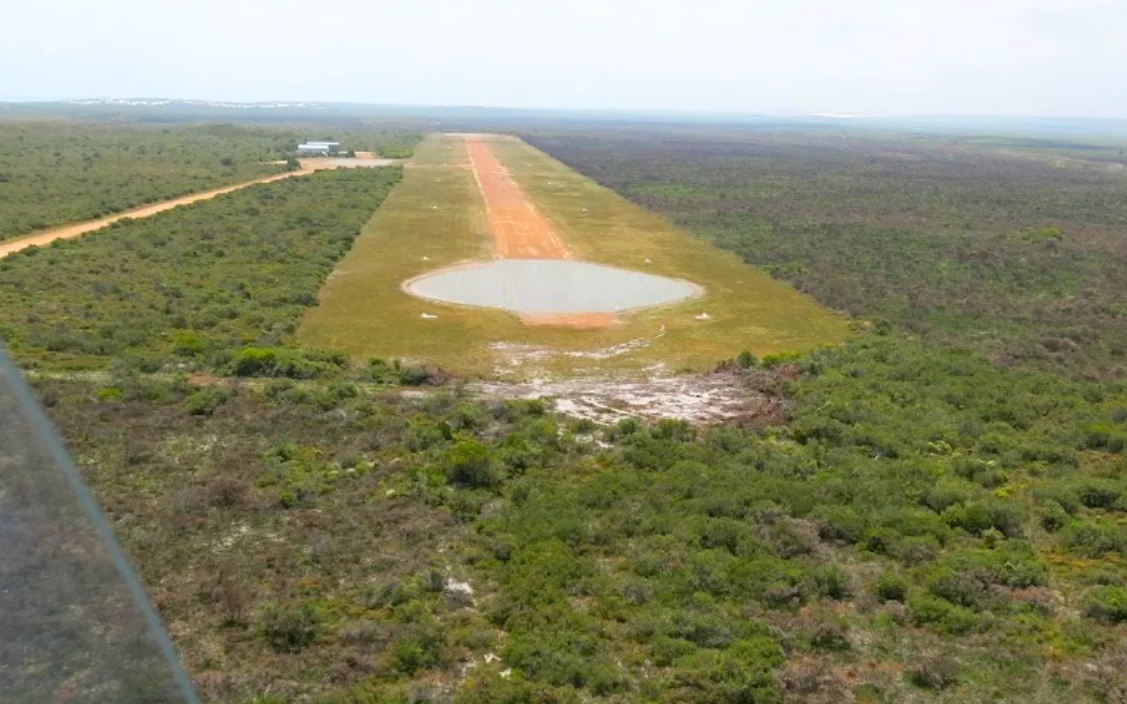
This one is on the list for its spectacular beach and ease of access from Perth. Cervantes Airport is located 179 km northwest of Perth and 2 km northeast of the town. The town is named after a Shipwreck that took place close by. Cervantes is the perfect little beach town, just far enough from Perth to be quiet but still only under an hour flight away.
The Cervantes runway is a 1000 m long dirt runway with hard surfaced landing zones on each end. It is operated by the Shire of Dandaragan but only has Aircraft Landing Area status and is not registered.
Both Cervantes Airport and its sister airport Jurien Bay, 20 km north, are in regular use with a vibrant aviation community. It was quite hard to find information on Cervantes Airport but ownership is mentioned in the Jurien Bay Airport master plan which is a good read to understand opportunites and challenges for the local aviation community.
Landing fees are not being charged at Cervantes Airport but $14 is being charged at Jurien Bay which by the way is a sealed runway.
The Western Australia coast does not disappoint and the beaches around this area are spectacular. From the airport it is a short 1.35 km walk to the beach.
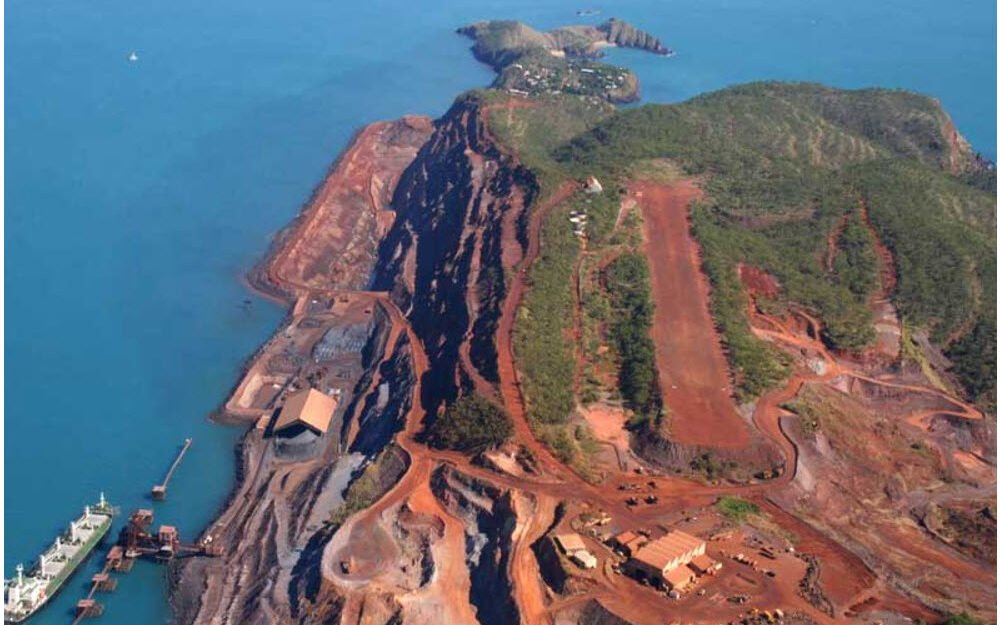
Okay, we jumped over a lot of places in Western Australia but its time for something a bit different. Cockatoo Island Airport is located 253 km northeast of Broome, Western Australia. It is a 1000 m airstrip built on the ridge of the island.
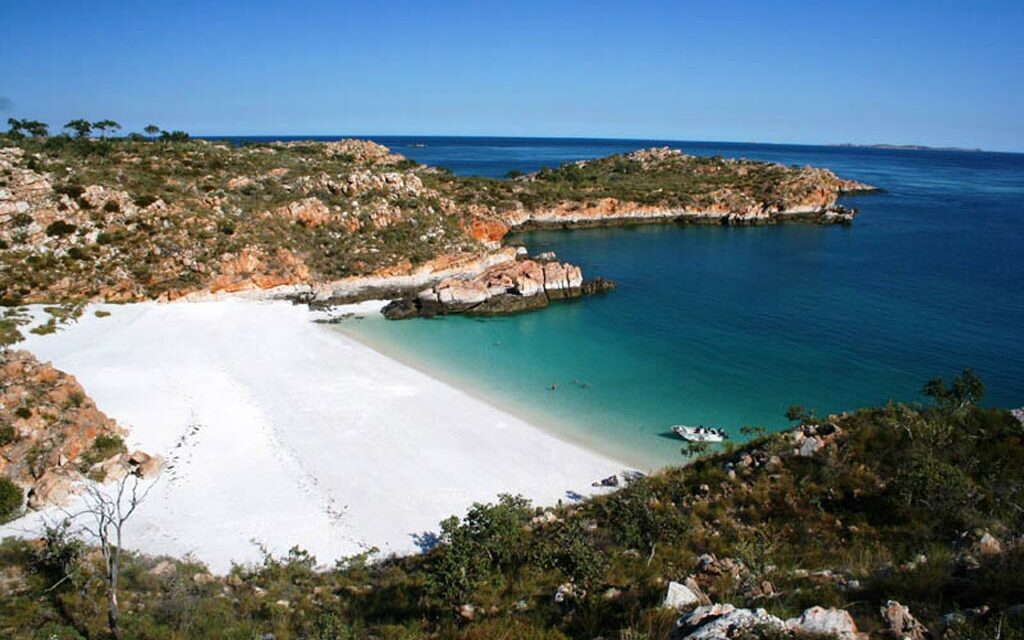 Silica Beach, northwest of Cockatoo Island
Silica Beach, northwest of Cockatoo Island
Weirdly this place is both an Iron Ore mine and a 5 star resort. The resort was built by Business tycoon Allan Bond in the 1980s. He went bankrupt in the 1990s but the Resort has since been rebuilt and is open for business.
Mining operations started much earlier here in the1950s along side sister mine on neighbouring Koolan Island. The rock on both islands contains 67% iron ore, making it some of the highest-grade iron ore in the world. From quite early people knew about the heavy rocks on the island and used them for ballast in ships.
Beaches on Cockatoo island are not so impressive, but a 20 km boat ride away you can find incredibly beautiful white beaches. This video gives some more info on the local attractions including the Horizontal waterfalls which are a freak of nature.
If you struggle landing on the 1000 m runway on Cockatoo Island, consider landing on the neighbouring Koolan Island Airport which has an impressive 2000 m paved runway. The mine operator decided it was cheaper to build a massive runway and bring miners in on regional jets than pay for smaller ferry flights.
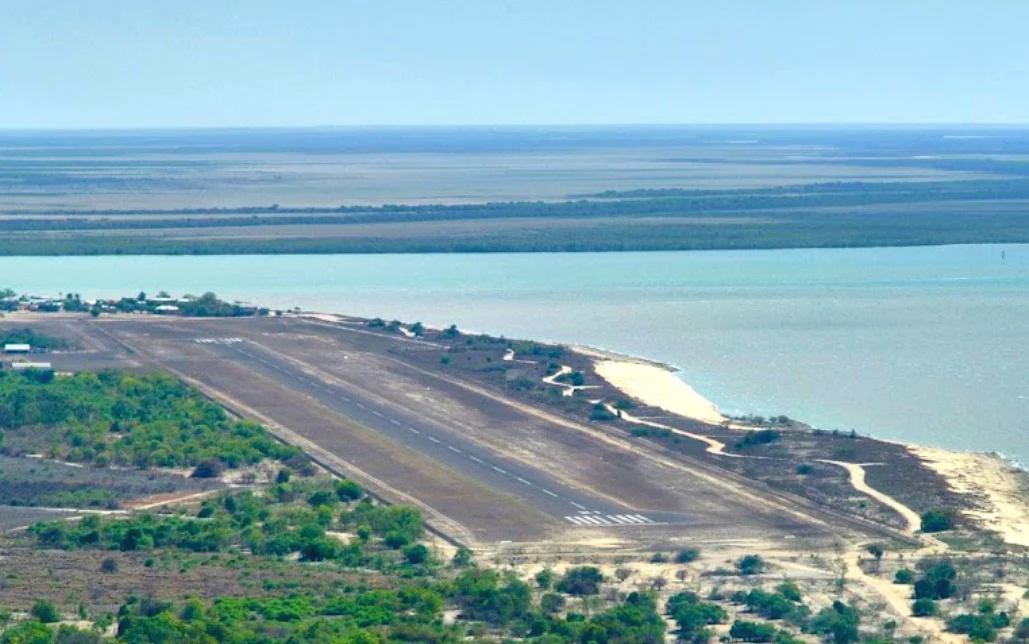
We have skipped over Darwin and are now back in sunny (and humid) Queensland in our circumnavigation of Australia. Our second last entry on othe list is Kurumba Airport which is located 528 km west of Cairns and 1206 km southeast of Darwin at the base of the Gulf of Carpentaria.
In the late1930s where the town is now was a refuelling station for QANTAS flying boats on their way to London. During the war, it was used for the same purpose by the Australian Airforce.
After the war, the area developed into a successful Commercial Fishing town for Crabs, Prawns, and Barramundi. Today it serves as the centre of Gulf fishing. There is also a modest tourism industry. This is the town’s website.
The Kurumba Airport is 1380 m long and 30 m wide and serves as a lifeline to the town which can be cut off during floods. The airport is owned and operated by the local council. Landing fees are $19 per tonne.
Just 100 m from the airport is a nice beach. Be sure though to keep an eye out as this is crocodile country, especially near the mouth of the Norman River.
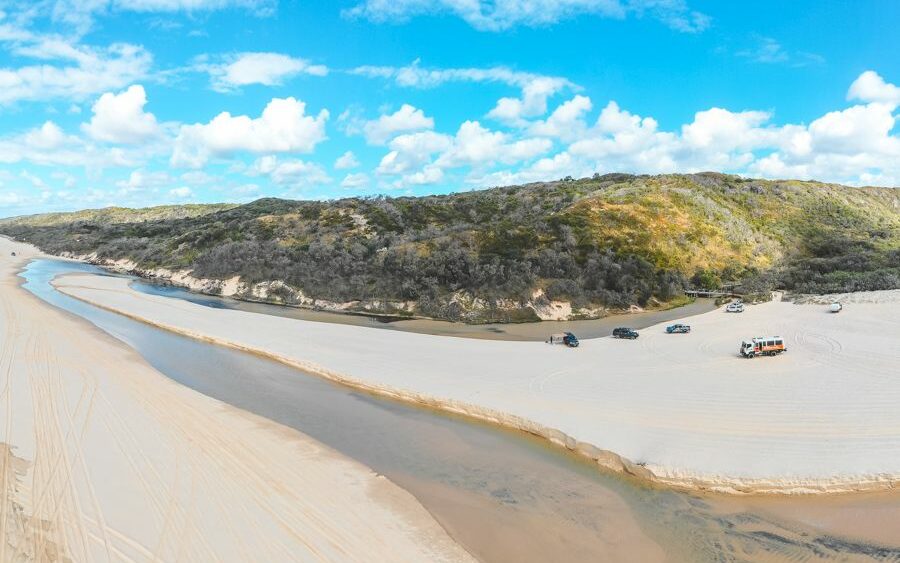
All roads seem to lead us back to Fraser Island. What better way to end than on Australia’s second only Commercial beach runway. Eli Creek Airstrip is 25 km north of Eurong Beach Airstrip used by the same Air Fraser Island tour operator
People want to visit this location because Eli Creek is the largest freshwater creek on Fraser Island, and as you can see from the picture it is lovely.
Because of the popularity of Eli Creek, Air Fraser has a steward control 4WD traffic on the beach during operations.
Here is a great video showing one of the Fraser Island Air’s GA8 Airvans taking off from the beach airstrip.
Happy flying!